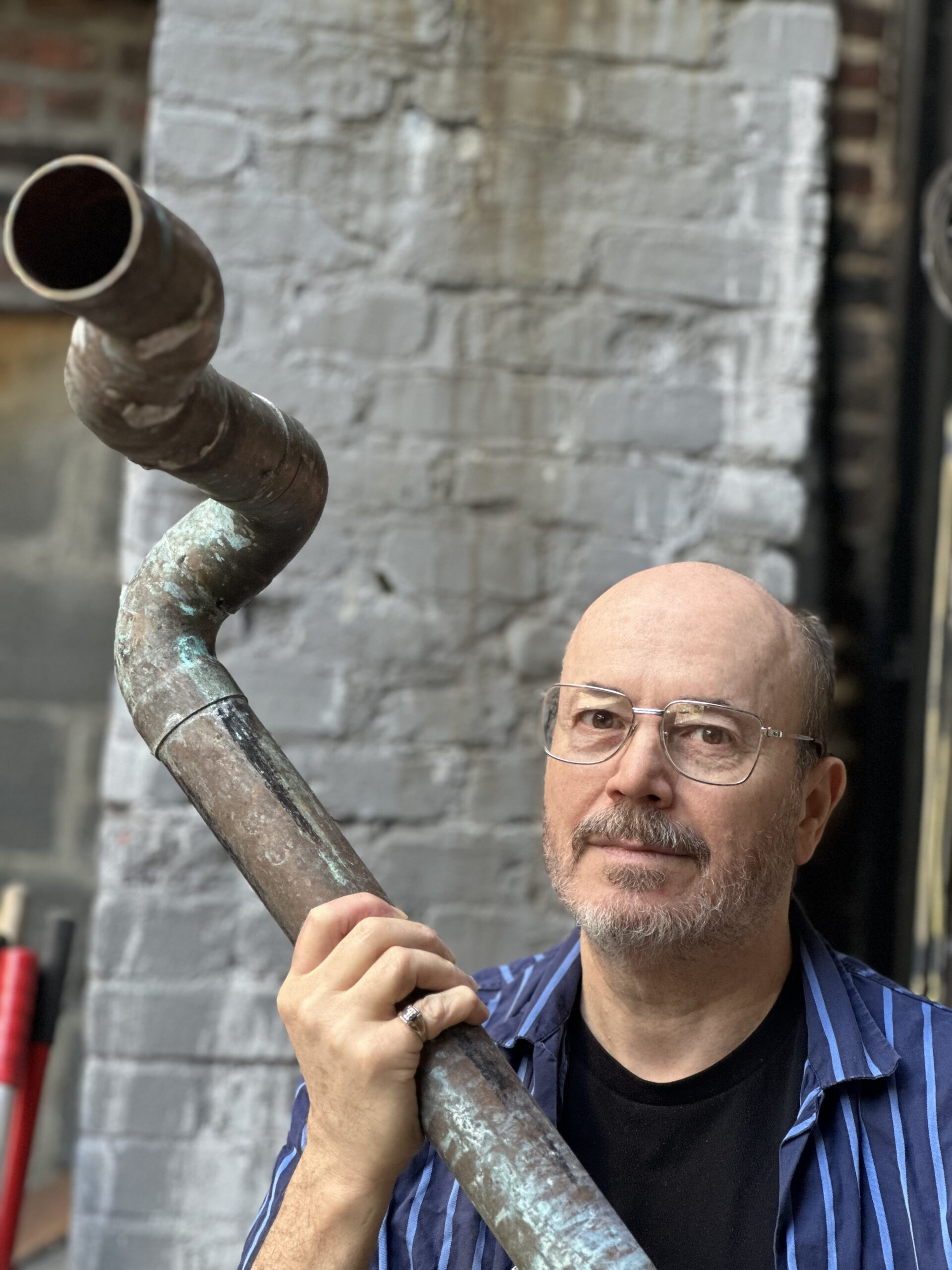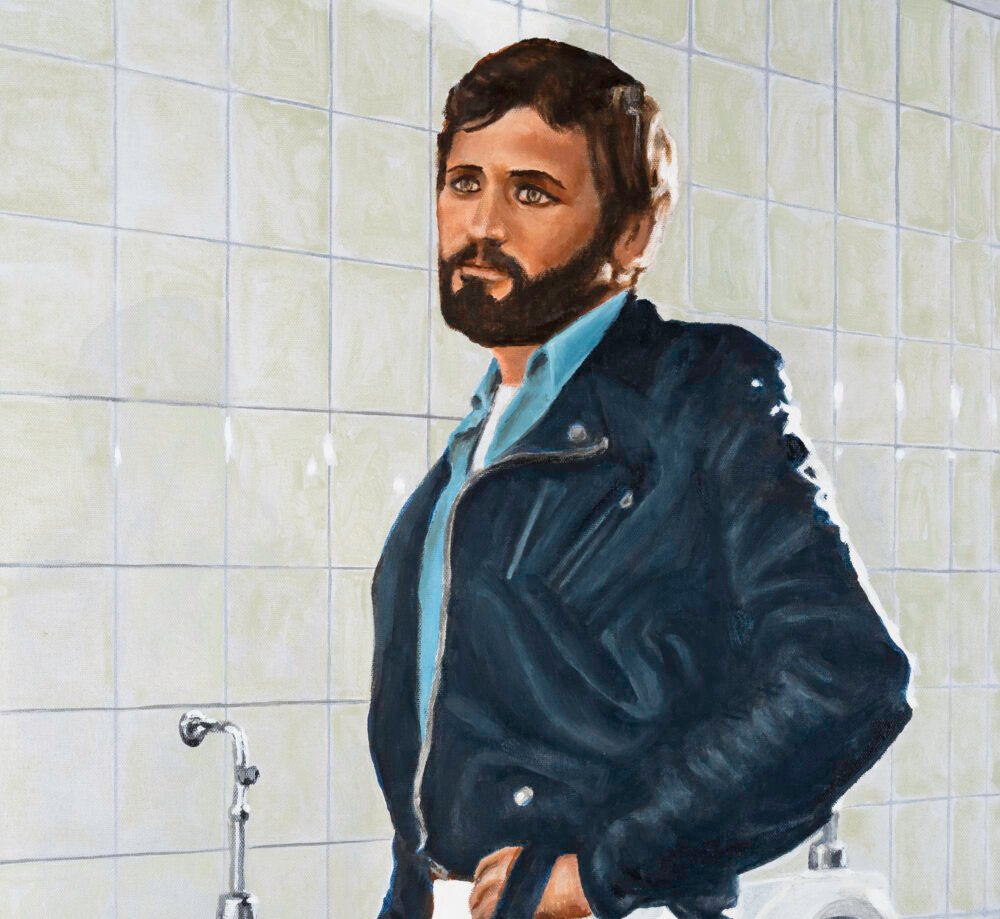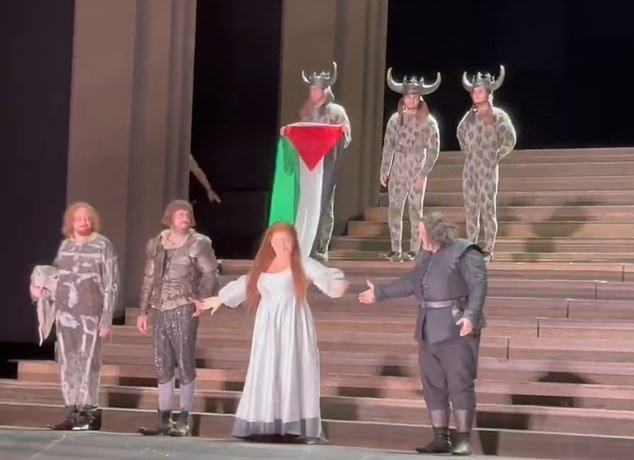
Lucky DeBellevue, photographed by Miranda Lichtenstein.
German filmmaker Rainer Werner Fassbinder once said, “It isn’t easy to accept that suffering can also be beautiful.” That quote could go a long way in describing the theme of his films. It’s also a handy aphorism to explain why artists with long, established careers continue to experiment and delve into uncharted corners of their studios. New York artist Lucky DeBellevue came to the forefront of the art world with his mesmerizing, weblike network sculptures made out of candy-colored chenille stems in the 1990s. This series is due for its own retrospective, but DeBellevue turns out to be an art journeyman, taking on new projects in a surprising wealth of materials—paints, prints, pistachio shells. Recently, he made a series of real and dreamed-up images of nude male artists. But his latest works, now showing at the downtown gallery Elliot Templeton, might be his most exciting and ambitious yet: a dreamy series of acrylic and oil paintings, erotic, dangerous, slightly mental, utterly bewitching, based on stills from various Fassbinder films. As it turns out, the series began as a memorial for a friend who happened to be a former lover of the notorious director. DeBellevue might be the most inspired and inspiring artist on the Lower East Side.
———
CHRISTOPHER BOLLEN: Hi Lucky. Are you feeling good post-opening?
LUCKY DeBELLEVUE: Yeah, I’m feeling really good. I was focused on this project for such a long time, it’s a little bit like, “What am I supposed to be doing now?”
BOLLEN: Did these Fassbinder paintings emerge during the pandemic? I feel like we’re only seeing all the great art and literature made during those dark days now.
DEBELLEVUE:. I started this series almost in tandem with the nude male artist series I was doing. [De Bellevue’s series of real and imagined nude portraits of male artists].
BOLLEN: Which I love. How many of those did you end up doing?
DEBELLEVUE: Maybe seven or eight paintings, and there’s lots of works on paper.
BOLLEN: Did you ever consider doing a nude of one of our mutual artist friends?
DEBELLEVUE: I have.

Franco/Querelle, 2023. Acrylic and water soluble oil on canvas. 24″ x 36″. Photo by PazosPazos.
BOLLEN: Is Wade [Guyton] going to be shocked by your next show?
DEBELLEVUE: You think he would?
BOLLEN: I mean, he’d probably be flattered, depending on what kind of girth you gave him.
DEBELLEVUE: I try to be honest. Initially I was thinking of more straight-identified artists, just kind of like, “You guys were always so comfortable showing nude women. Well, what about you?”
BOLLEN: Who were the most contemporary artists you ended up doing?
DEBELLEVUE: Some were real and some were fake. As far as a real one, Frank Stella actually posed nude with one of his paintings. But I did a fake of Gerhard Richter.
BOLLEN: I remember that Frank Stella photo because he’s so handsome in it.
DEBELLEVUE: I thought so too. Kind of almost like a stereotype of some wiry Bohemian artist.
BOLLEN: So these portraits were consuming you when Fassbinder entered your life.
DEBELLEVUE: The impetus behind that is that it began as a tribute to my friend Frank Wagner, who was a curator who supported my work early on. He curated my first show in Europe in the late ‘90s. And he was one of Fassbinder’s last lovers.
BOLLEN: No way.
DEBELLEVUE: Yeah. He died a few years ago of cancer.
BOLLEN: Where was he living?
DEBELLEVUE: In Berlin. We were starting to lose contact, but he’d been an important person in my life. During his memorial service, one of the speakers was my friend, Stephen Evans. He recounted this story where Fassbinder wanted Frank, who was a college student at the time, to leave school and just be with him. Frank said, “My parents struggled to put me through university.” Apparently his mother was taught how to make pizza from American GIs after World War II and opened up a pizza parlor, which became very successful. So Frank said, “I was not going to leave college to join Fassbinder.” Apparently, one of Fassbinder’s last ploys was to invite him to lunch. And who is sitting there with Fassbinder? Jeanne Moreau.
BOLLEN: Oh my dod.
DEBELLEVUE: He was trying to entice him away.
BOLLEN: That’s a pretty good enticement. I always think of that Jeanne Moreau singing that song in Querelle. “Each Man Kills the Thing He Loves.” So Frank didn’t go with Fassbinder and ended up having a successful career as a curator?
DEBELLEVUE: Yes. In 2006, he put me in a show that was at the Museum Ludwig about gay identities called The Eighth Square. I installed one of the works I initially did for the Whitney Philip Morris Atrium.
BOLLEN: I saw your show at the Whitney Atrium. It was your pipe-cleaner sculptures. Do you refer to them as pipe cleaners?

Satansbraten, 2022. Acrylic and water soluble oil on canvas. 28” x 22”. Photo by PazosPazos.
DEBELLEVUE: When I worked with Hudson from Feature gallery, we talked about the material and he said, “You always put what’s on the package.” What’s on the package for those materials is chenille stems.
BOLLEN: Those chenille stem works were exquisite. I always wondered why you stopped making them. With admiration. I always admire when artists are successful with one material and still are willing to go in a totally different direction.
DEBELLEVUE: You know how you kind of know when something’s over? Like a relationship or something?
BOLLEN: Actually, I have trouble knowing when a relationship is over.
DEBELLEVUE: Well, a friend of mine was like, “You need to change your work. You’ve been doing this for so long.” And I just felt it. And some of that work was very labor-intensive. I was like, “It’s just not paying off for me.” Also, some artists have the luxury and/or maybe the curse of everything you do just flies out the door and sells. It’s not like collectors were clamoring for that work. So it just felt organic to try something else.
BOLLEN: You’ve explored so many different materials in your career. You do paintings, sculptures, prints. Do you have total confidence when picking up a new material?
DEBELLEVUE: It really does stem from having a strong desire to do something else. And as long as a material is giving me something that I think feels like what I should be doing, then I go with it. That’s what happened during the pandemic. I was making some work in the vein of using printmaking and pistachio shells. And no matter what I did, it was not working. I don’t know what it is, but I can’t kid myself anymore. And that’s when I started exploring and doing this other work.
BOLLEN: How many paintings of Fassbinder films had you done when you realized it was its own series?
DEBELLEVUE: I just decided I was going to do at least a few of them. Because looking at Fassbinder’s work, he was so prolific. I knew that there were so many images that I would get something out of and want to realize in a watercolor or a painting.
BOLLEN: How did you choose the scenes? I hadn’t seen a Fassbinder film until I went to college. There was an indie video store near campus and I remember stumbling upon Fox & His Friends and The Bitter Tears of Petra Von Kant and being blown away. I couldn’t watch Fassbinder fast enough. So tragic and sexy and beautifully shot.
DEBELLEVUE: I decided I didn’t want to shy away from sexuality. I thought it was important to have that aspect of the work, because that’s part of life. Some of that stuff actually makes me feel uncomfortable, and I sometimes do exactly what makes me feel uncomfortable, like making work out of pipe cleaners. There’s something so fraught about his characters, and so it was a combination of choices in terms of picking scenes. Sometimes it was just formally, I just thought, “Oh, I love this image.” And sometimes I thought, “Well, this is evoking something intense.” There’s this quote by him where says his work is about the exploitability of emotions. And I was reading about him and a writer said, he grew up right after World War II ended. He saw the aftermath of emotions being exploited by Hitler. I know he was also influenced by Douglas Sirk and other American directors. So, it was a whole sensibility.
BOLLEN: The relationship between queerness and villainy in Fox & His Friends fascinates me. It’s not a sugar-coated view of homosexuality.
DEBELLEVUE: I’ll say!

Nietzsche?, 2022. Acrylic and water soluble oil on canvas. 22″ x 28″. Photo by PazosPazos.
BOLLEN: Our mutual friend Judith Eisler is also a painter of films. I know her process involves taking a photograph of a screen, and she captures all the technical disruptions of that process. How did you capture the still film images?
DEBELLEVUE: I love Judith’s paintings. For me, it was a combination of finding film stills online on my computer and actually watching the films and taking photographs of it as I was watching it. The last painting I finished in the show was of The Marriage of Maria Braun, from the final scene where she blows out the gas stove flame and the house blows up. It took me a long time to capture the moment when she blew out the flame. I kept rewinding and rewinding and watching it until I got the image I wanted.
BOLLEN: What about the colors? How faithful were you to the original film colors?
DEBELLEVUE: I tried to replicate the colors, and what I found out when I was making these paintings is that painting is hard. I hadn’t been a painter in a really, really long time. I tried to replicate what I saw. And then I thought, “Well, what do I want these to be?” They are paintings. I don’t want to just make illustrations.” So towards the end of this series, I started taking a few liberties just to make it a better painting. It’s hard to get the replication of a certain glow that’s in film.
BOLLEN: Because ultimately it’s an image constructed out of light. Were you in your studio on the Lower East Side throughout the pandemic?
DEBELLEVUE: Yeah. I work and live in the same place on the Lower East Side. I’m the old-timer. I’ve been here since the late ’80s.
BOLLEN: You must have amazing rent.
DEBELLEVUE: Yes. That’s what’s keeping me here, for the most part. But no, I actually really love my apartment. Let’s just say I’ve seen the neighborhood really change a lot. Some of it’s good. I kind of wished it was still a little bit more underground or not as discovered, but that’s the story of New York.
BOLLEN: On the good side of New York, you’re showing this series at Jack Pierson’s new gallery. To me, that gallery is the perfect antidote to gentrified, impersonal Manhattan. It feels intimate and old school. Jack actually has a position and an aesthetic fully his own.
DEBELLEVUE: I happened to be at another gallery visiting a gallerist down the street from his space and he came in to see her show. He told me to stop by and so I went. I was just talking to him about what I was up to, and he is like, “Oh, I want to come by.” It all happened so quickly. He came by with Evan and he offered me a show right then.
BOLLEN: The paintings look perfect on the Elliot Templeton mauve walls. Now that you’ve shown these works, do you consider the series finished?
DEBELLEVUE: There are one or two more that I feel compelled to finish, but then I want to say goodbye. I feel like I could make these for the rest of my life, so I want to move on to something else.
BOLLEN: You never stop moving. Thanks for talking, Lucky.
DEBELLEVUE: Well, thank you so much, Chris. I appreciate it.

Jeanne/Querelle, 2023. Acrylic and water soluble oil on canvas. 24″ x 36″. Photo by PazosPazos.






